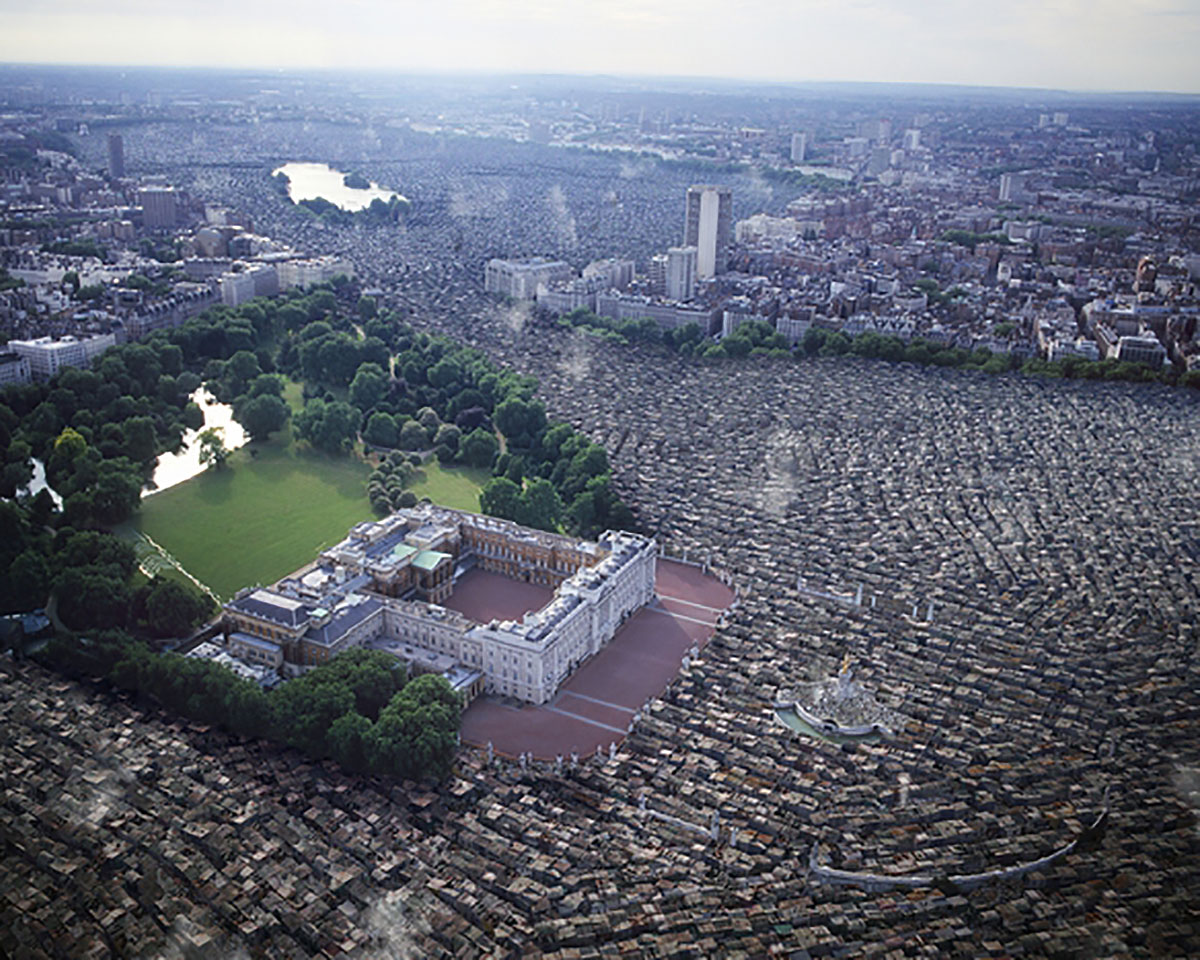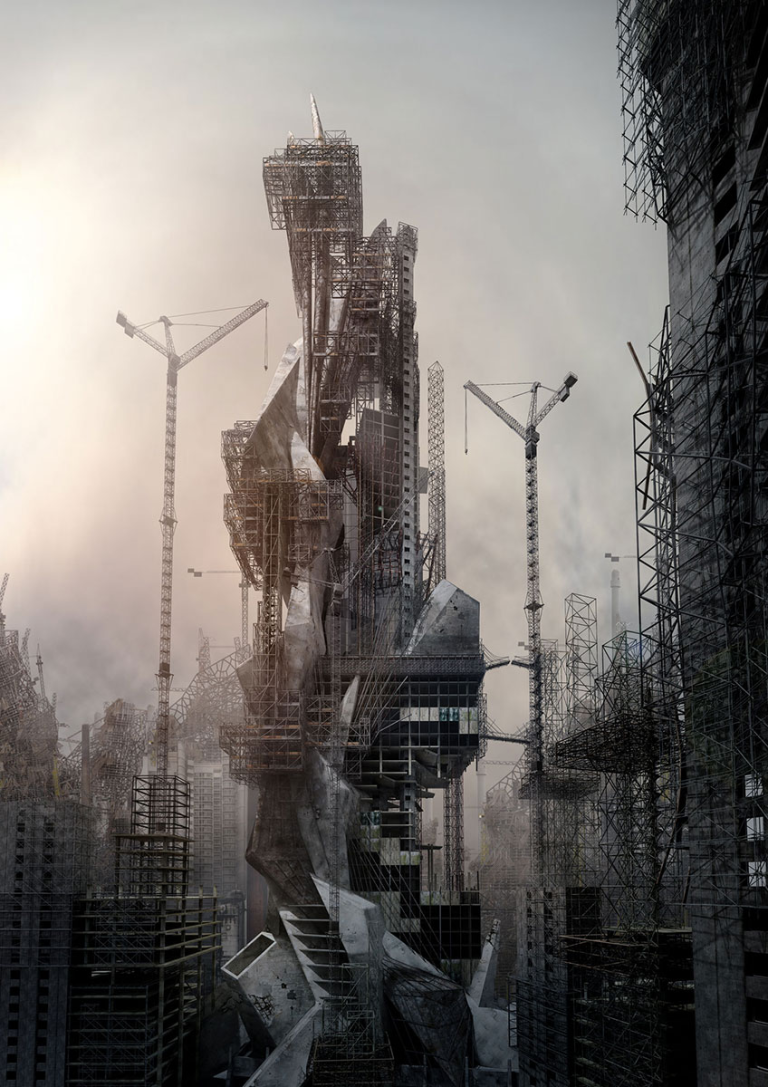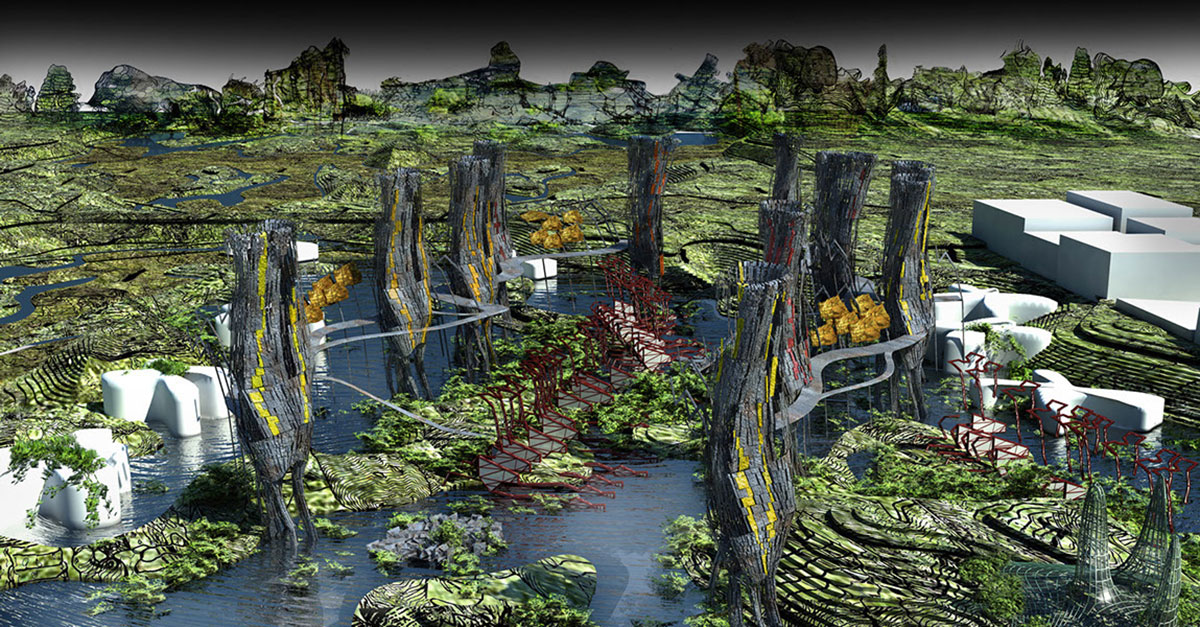Paul Dobraszczyk imagines a dystopian future for the city in which its inhabitants' survival depends on salvaging the wastes of an economic system long gone.

'Buckingham Palace Shanty', an image from Robert Graves and Didier Madoc-Jones's series Postcards from the Future (2010). Credit: Robert Graves and Didier Madoc-Jones, aerial photograph by Jason Hawkes
The skyscrapers that were abruptly abandoned were mostly unfinished structures, the frenzied rate of construction only ever accelerating after each successive crash. But these monolithic buildings didn’t stay empty for long. Enterprising migrants that had already built vast shantytowns on central London’s acres of parkland saw an opportunity to better themselves and moved into the most promising of these structures.
Gathering waste materials from a vast array of sites across the city, the migrants gradually filled in the gaps between the concrete pillars with bits of plastic, canvas, broken breeze-blocks and irregularly-shaped bricks. Leftover scaffolding provided a handy material for adding balconies and walkways to the external walls, creating places to collect rainwater as well as to grow food. The higher up you were able to live, the more pleasant your existence would be: afternoon breezes tempered the oppressive humidity of the omnipresent tropical heat, even if, at night, sleeping was no easier.
Meanwhile, as the shantytowns emptied of migrants, native Londoners moved in from the suburbs, eager to learn the skills now necessary for survival and which they had long taken for granted in their Victorian semis and terraces. The old infrastructural networks that held their suburban houses together no longer functioned – the hidden sewers, water and gas pipes, and electricity cables now a barrier to a new kind of existence off the grid. At least some of these once well-heeled Londoners were able to appreciate the irony of living in self-made shacks in the grounds of Buckingham Palace; long abandoned, its bloated spaces of no use to anyone now.

Still from Jonathan Gales’s short-film Megalomania (2014). Credit: Jonathan Gales / Factory Fifteen
Over time, when it became clear that nobody was ever going to return to claim these buildings, half-finished or otherwise, the adaptations became ever more daring and outlandish and they spread to other, more unlikely structures. Like London Bridge in the medieval period, some of the city’s river crossings became inhabited again; favoured bridges being those with towers of iron and steel. Stripped bare of its stone cladding, the superstructure of Tower Bridge now supported within its metal mesh a fantastic bricolage of salvaged materials, held together by a mixture of rope, wire, nails and screws. As the Thames swelled and eventually cascaded over its Victorian embankments, most of the bridges held fast and became vital places to access the only viable source of drinking water in the city, cleansed as it was twice daily by the surging tides. Now, Tower Bridge was connected to the waters beneath it via a tangle of pulleys, buckets and rope ladders, the floating platforms beneath supporting a vast array of tiny vessels that ploughed the Thames for vital sources of protein.
On the other side of the city, in the permanently flooded regions of the East End, a vast intertidal region gave birth to an altogether new kind of shanty town, one that had literally grown out of the flood waters themselves, but which was also a result of some degree of foresight and expertise. Many architects had since left London – retreating to their country villas in the far north – but some who had seen the storm coming and embraced it in advance had already worked out how to take advantage of the urban landscape that would likely emerge in the future. Developing a new kind of living infrastructure, these architects found a way to combine waste materials and tropical vegetation to form hybrid structures. Over several decades in the swampy lowlands of Bow, an experimental community emerged.

CRAB Studio, Soak City, 2009, perspective view. Credit: CRAB Studio
Of course, these salvage communities – whether the former middle-classes in the old shanties in the parks, the adhoc-ist migrants in the skyscrapers, or the professionals and technicians in the sophisticated vegetated towers – knew that their continued existence depended on the wastes of an economic system now long gone. But in a vast city like London, those wastes would likely not run out anytime soon, particularly as the majority of citizens had fled to find an easier life somewhere else.
After a time, these emerging communities began to mix more freely. Skilled in an entirely new way, they were eventually able to create a new city out of the ruins of the old. Nobody in this transformed world assumed any measure of control, let alone tried to form a coherent government. Continuous challenges forced them to organise on the hoof – nothing else worked when so much around them was wreckage. To achieve any kind of order in this city was itself a form of heroism, the burden of which was taken up time and again at the dawning of each new day.
Paul Dobraszczyk is a teaching fellow at The Bartlett School of Architecture and author of Future Cities: Architecture and the Imagination (2019)
 Close
Close




